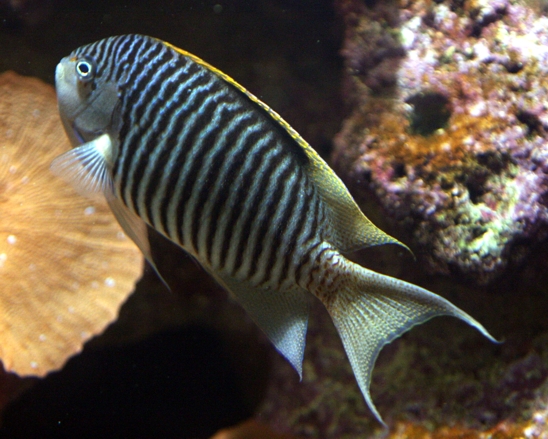Aquarium

Palm tree polyps, Clavularia viridis
The Palm tree polyp is a colonial, encrusting mat-like coral whose eight tentacles have feathery pinnules resembling the branches of a palm tree, thus its common name. The polyps can be found in a variety of colors including brown, cream, green, pink, purple, white and yellow, while the mat that contains the polyps is brown, gray or tan.
LEARN MORE
Blackeye goby, Rhinogobiops nicholsii
The body of the Blackeye goby (Rhinogobiops nicholsii) is usually a light beige to olive in color with darker spots and mottling. The body coloration and its spots can change if needed. A thick black edge can be seen on the fore-dorsal fin. The raised, big black eyes are responsible for its common name.
LEARN MORE
Harlequin shrimp, Hymenocera picta
The colorful pattern of the Harlequin or Clown shrimp makes this beautiful crustacean quite popular. Its white or cream colored body is covered with distinctive red and purple spots. It has ten legs; the first pair are modified large, flattened claws (chelipeds). The eyes are located on stalks. The first pair of antennae on the head resemble a flattened leaf that sense the smell of nearby prey.
LEARN MORE
Pot-bellied seahorse, Hippocampus abdominalis
Pot-bellied seahorses, as the name suggests, have a large swollen belly. Like other seahorses, this species comes in a wide range of colors – brown, yellow, gray, white, orange or mottled with dark spots on its head and trunk. They have a forward-tilted, long-snouted head, eyes that can move independently of each other and a prehensile tail. Males and females differ in appearance. Males have a longer tail, a shorter snout and a smooth soft pouch-like area at the base of the abdomen. Females have more of a pointed stomach.
LEARN MORE
Zebra angelfish, Genicanthus caudovittatus
In contrast to many other angelfish, which live in pairs, swallowtail angels, in the genus Genicanthus live like fairy basslets, with a dominant male guarding a harem of females. As with fairy basslets, if the male dies, the dominant female will become male and take charge of the harem. This species is found only in the Red Sea and the Western Indian Ocean. Only the male has the zebra pattern but only the female has the black stripes at the top and bottom of the tail, commemorated by the Latin name “caudovitatu”, which means “striped tail”.
LEARN MORE
Colt coral, Cladiella sp.
The Colt coral is a soft, branching coral that is found in Indo-Pacific coral reefs. It does not have the calcium carbonate skeleton of the reef building corals. It is a hardy aquarium species and is commonly cultured. Like other corals, its tissues are home to photosynthetic algae known as zooxanthellae which provide the coral with oxygen and nutrients.
LEARN MORE
Red mushroom anemone, Actinodiscus sp.
The Red mushroom anemone is also known as Mushroom coral or Disc anemones. They can vary in shade from red to pink or purple and are a hardy aquarium species. Symbiotic algae, known as zooxanthellae, are responsible for the red color and also provide the coral with nutrients and oxygen. These corals readily reproduce in an aquarium by a cloning process known as budding.
LEARN MORE
Napoleon wrasse, Cheilinus undulatus
Named for its profile reminiscent of a French military cap, this fish is also known as the Humphead, and Maori wrasse (for its intricate cheek designs that look tattooed), and, because of its enormous size, Truck wrasse. The largest of all the wrasses, males can grow more than six feet in length and weigh over 300 pounds. In common with many other large Indo-Pacific reef fishes, it has been over-exploited by Chinese restaurants that serve live fishes. Trade of this animal is protected under CITES.
LEARN MORE
Carberryi anthias, Nemanthias carberryi
Like other fairy basslets, the Carberryi or Threadfin anthias lives in small schools composed of a dominant male and his harem of females. This species is found only in the Indian Ocean. It was described for science in 1954, one of 370 new fish species named by the famous South African ichthyologist J.L.B. Smith, who rediscovered the Coelacanth.
LEARN MORE
Moorish idol, Zanclus cornutus
Like toucans and macaws, this fish has become a quintessential symbol of the Tropics, appearing as all sorts of kitschy souvenirs and “decorations”. It is often seen on postcards from Florida (where it is not found!). It is also familiar as “Gill”, in the Disney / Pixar movie, “Finding Nemo”. Because its tiny larvae travel well in plankton, it is found all the way from the East Africa, clear across the Indian Ocean and Pacific, to the west coast of Mexico, south to Peru. It is closely related to tangs and surgeonfish, but lacks their “scalpel”.
LEARN MORE

